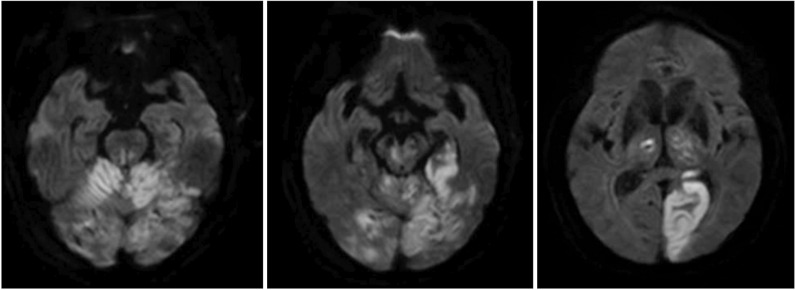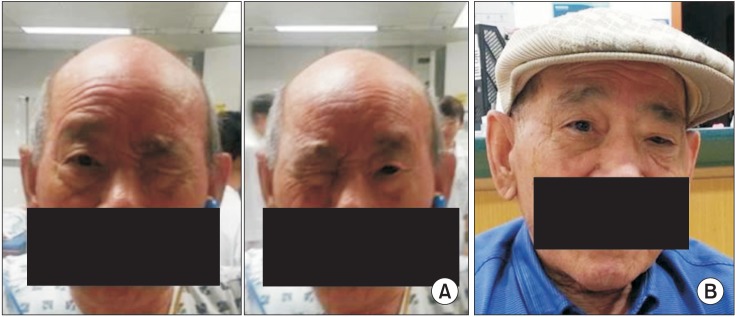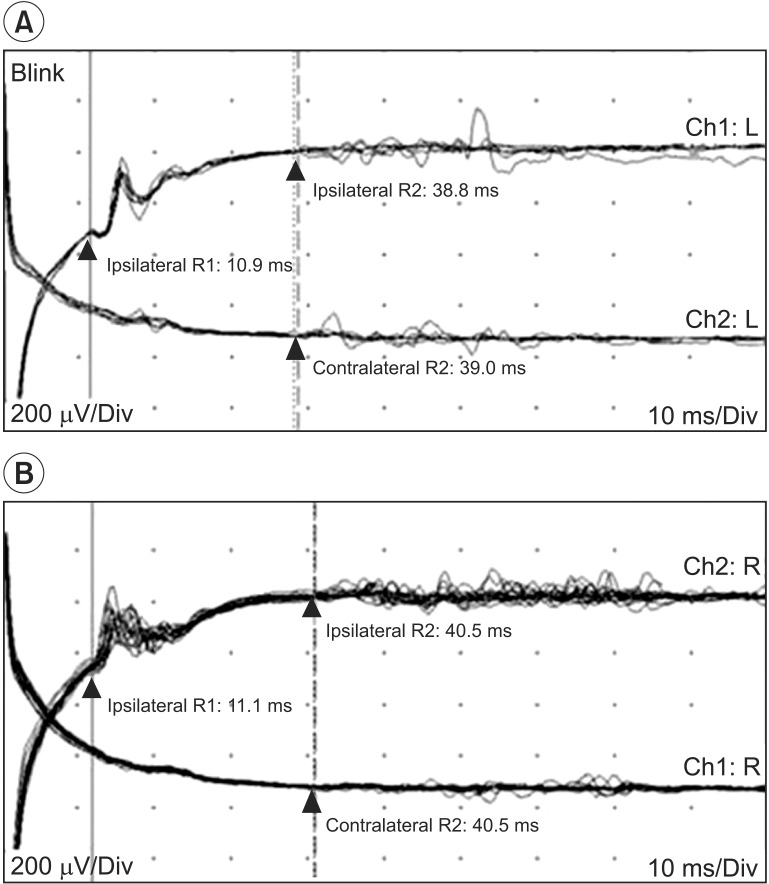Ann Rehabil Med.
2015 Apr;39(2):303-307. 10.5535/arm.2015.39.2.303.
Simultaneous Loss of Bilateral Voluntary Eyelid Opening and Sustained Winking Response Following Bilateral Posterior Cerebral Artery Infarction
- Affiliations
-
- 1Department of Rehabilitation Medicine and Research Institute of Rehabilitation Medicine, Yonsei University College of Medicine, Seoul, Korea.
- 2Department of Rehabilitation Medicine, Severance Hospital, Seoul, Korea.
- 3Department of Physical Medicine and Rehabilitation, National Health Insurance Service Ilsan Hospital, Goyang, Korea. rekhs@nhimc.or.kr
- KMID: 2273053
- DOI: http://doi.org/10.5535/arm.2015.39.2.303
Abstract
- Spontaneous opening and closing of both eyes usually occurs in the normal awake state, unless a deliberate and voluntary attempt is made to open only one eye. We present a rare case of a male patient who was unable to open both eyes simultaneously after bilateral posterior cerebral artery infarction. He was able to close both eyes voluntarily. However, he was unable to keep both eyes open simultaneously and either the right or left eye remained closed. Upon a verbal command to open both eyes, the opened eye closed and the contralateral eye opened. When the closed eye was forced open, the opened eye closed. We thus presented a case of right-left dissociation of voluntary eyelid opening following bilateral posterior cerebral artery infarction, which was treated with botulinum toxin type A injection. Differential diagnosis to other movement disorders of the eyelids was discussed.
Keyword
MeSH Terms
Figure
Reference
-
1. Cruz AA, Garcia DM, Pinto CT, Cechetti SP. Spontaneous eyeblink activity. Ocul Surf. 2011; 9:29–41. PMID: 21338567.
Article2. van Koningsbruggen MG, Peelen MV, Davies E, Rafal RD. Neural control of voluntary eye closure: a case study and an fMRI investigation of blinking and winking. Behav Neurol. 2012; 25:103–109. PMID: 22530264.
Article3. Esteban A, Traba A, Prieto J. Eyelid movements in health and disease. The supranuclear impairment of the palpebral motility. Neurophysiol Clin. 2004; 34:3–15. PMID: 15030796.
Article4. Schmidtke K, Büttner-Ennever JA. Nervous control of eyelid function: a review of clinical, experimental and pathological data. Brain. 1992; 115 Pt 1:227–247. PMID: 1559156.5. Esteban A, Gimenez-Roldan S. Involuntary closure of eyelids in parkinsonism: electrophysiological evidence for prolonged inhibition of the levator palpebrae muscles. J Neurol Sci. 1988; 85:333–345. PMID: 3210029.6. Defazio G, Livrea P, Lamberti P, De Salvia R, Laddomada G, Giorelli M, et al. Isolated so-called apraxia of eyelid opening: report of 10 cases and a review of the literature. Eur Neurol. 1998; 39:204–210. PMID: 9635470.
Article7. Nashold BS Jr, Gills JP, Wilson WP. Ocular signs of brain stimulation in the human. Confin Neurol. 1967; 29:169–174. PMID: 4232575.8. Aramideh M, Ongerboer de, Koelman JH, Speelman JD. Motor persistence of orbicularis oculi muscle in eyelid-opening disorders. Neurology. 1995; 45:897–902. PMID: 7746403.
Article9. Keam SJ, Muir VJ, Deeks ED. Botulinum toxin A (Dysport®): in dystonias and focal spasticity. Drugs. 2011; 71:1043–1058. PMID: 21668041.
- Full Text Links
- Actions
-
Cited
- CITED
-
- Close
- Share
- Similar articles
-
- Kluver-Bucy Syndrome Following Bilateral Posterior Cerebral Artery Infarction
- Cortical Deafness Caused by Bilateral Acute Middle Cerebral Artery Infarctions
- Bilateral Superior Cerebellar Artery Infarction after Stent-Angioplasty for Internal Carotid Artery Stenosis
- Apraxia of Eyelid Closing and Unilateral Meige's Syndrome Complicating Left Middle Cerebral Artery Infarction
- Apraxia of Eyelid Opening Secondary to Right Thalamic Infarction




